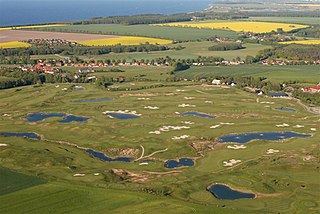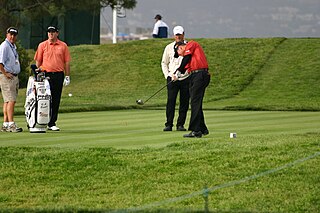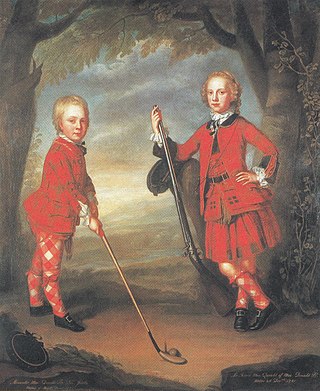
Samuel Jackson Snead was an American professional golfer who was one of the top players in the world for the better part of four decades and widely regarded as one of the greatest players of all time. Snead was awarded a record 94 gold medallions, for wins in PGA of America Tour events and later credited with winning a record 82 PGA Tour events tied with Tiger Woods, including seven majors. He never won the U.S. Open, though he was runner-up four times. Snead was inducted into the World Golf Hall of Fame in 1974.

Jack William Nicklaus, nicknamed "the Golden Bear", is a retired American professional golfer and golf course designer. He is widely considered to be either the greatest or one of the greatest golfers of all time. He won 117 professional tournaments in his career. Over a quarter-century, he won a record 18 major championships, three more than second-placed Tiger Woods. Nicklaus focused on the major championships—the Masters Tournament, U.S. Open, Open Championship and PGA Championship—and played a selective schedule of regular PGA Tour events. He competed in 164 major tournaments, more than any other player, and finished with 73 PGA Tour victories, third behind Sam Snead (82) and Woods (82).
Golf instruction is the art of equipping and training golfers to play better golf through improved awareness of swing cause and effects as a result of the actions by their body, the club, and their effect on the golf ball. Most great golfers have a few common elements that make them great including: proper intentionality, swing repeatability to produce an action that fits the golfers intentionality, and a strong level of automaticity for long lasting enjoyment of the game golf.

A golf course is the grounds on which the sport of golf is played. It consists of a series of holes, each consisting of a tee box, a fairway, the rough and other hazards, and a green with a cylindrical hole in the ground, known as a "cup". The cup holds a flagstick, known as a "pin". A standard round of golf consists of 18 holes, and as such most courses contain 18 distinct holes; however, there are many 9-hole courses and some that have holes with shared fairways or greens. There are also courses with a non-standard number of holes, such as 12 or 14.

Thomas Sturges Watson is an American retired professional golfer on the PGA Tour Champions, formerly on the PGA Tour.
A golf club is a club used to hit a golf ball in a game of golf. Each club is composed of a shaft with a grip and a club head. Woods are mainly used for long-distance fairway or tee shots; irons, the most versatile class, are used for a variety of shots; hybrids that combine design elements of woods and irons are becoming increasingly popular; putters are used mainly on the green to roll the ball into the hole. A set of clubs is limited by the rules of golf to a maximum of 14 golf clubs, and while there are traditional combinations sold at retail as matched sets, players are free to use any combination of legal clubs.
The following is a glossary of the terminology currently used in the sport of golf. Where words in a sentence are also defined elsewhere in this article, they appear in italics. Old names for clubs can be found at Obsolete golf clubs.

Thomas Morris, known as Tom Morris Junior, Young Tom Morris and also Tommy Morris, was a Scottish professional golfer. He is considered one of the pioneers of professional golf, and was the first young prodigy in golf history. He won four consecutive titles in the Open Championship, and did this by the age of 21.

In the sport of golf, a wedge is a subset of the iron family of golf clubs designed for special use situations. As a class, wedges have the highest lofts, the shortest shafts, and the heaviest clubheads of the irons. These features generally aid the player in making accurate short-distance "lob" shots, to get the ball onto the green or out of a hazard or other tricky spot. In addition, wedges are designed with modified soles that aid the player in moving the clubhead through soft lies, such as sand, mud, and thick grass, to extract a ball that is embedded or even buried. Wedges come in a variety of configurations, and are generally grouped into four categories: pitching wedges, sand wedges, gap/approach wedges and lob wedges.
The following is a partial timeline of the history of golf.

The Tucson Open was a golf tournament in Arizona on the PGA Tour from 1945 to 2006, played annually in the winter in Tucson. It was last held at the Omni Tucson National Golf Resort in late February, with a $3 million purse and a $540,000 winner's share.

Golf equipment encompasses the various items that are used to play the sport of golf. Types of equipment include the golf ball, golf clubs, and devices that aid in the sport.

Robert Ira Garrigus is an American professional golfer who is currently a member of the PGA Tour. He won the 2010 Children's Miracle Network Classic, the last event of the PGA Tour season, to guarantee exempt status on the PGA Tour through the end of the 2012 season.

An iron is a type of club used in the sport of golf to propel the ball towards the hole. Irons typically have shorter shafts and smaller clubheads than woods, the head is made of solid iron or steel, and the head's primary feature is a large, flat, angled face, usually scored with grooves. Irons are used in a wide variety of situations, typically from the teeing ground on shorter holes, from the fairway or rough as the player approaches the green, and to extract the ball from hazards, such as bunkers or even shallow water hazards.

The 2001 United States Open Championship was the 101st U.S. Open, held June 14–18 at Southern Hills Country Club in Tulsa, Oklahoma. The U.S. Open returned to Southern Hills for the first time since 1977. Retief Goosen won the first of his two U.S. Open titles in an 18-hole Monday playoff, two strokes ahead of runner-up Mark Brooks. The tournament was also notable for ending defending champion Tiger Woods' run of four consecutive major championship wins, the "Tiger Slam;" he finished seven strokes back in a tie for twelfth. Woods reclaimed the U.S. Open title the following year, and won the PGA Championship at Southern Hills in 2007.

John Erickson is an American professional golfer who played the Canadian Tour from 1987 to 1994 and the PGA Tour of Australasia Tour from 1987 to 1992.

Golf is a club-and-ball sport in which players use various clubs to hit a ball into a series of holes on a course in as few strokes as possible.

The golf swing is the action by which players hit the ball in the sport of golf. The golf swing is a complex motion involving the whole body; the technicalities of the swing are known as golf stroke mechanics.
A lob wedge, also known as a lofted wedge or an L-Wedge, is a wedge used in the sport of golf, known for being one of the shortest-hitting clubs and providing the most loft on a shot. Lob wedges are used to produce shots with a very high arc, and are most often used for shots over hazards and other obstructions. Due to the high arc of the shot the lob wedge, like the other wedges in the set of irons, produces little roll after landing on the putting green and can even be used to produce backspin if necessary. Lob wedges are one of the newest additions to the modern collection of golf clubs and, along with the sand wedge and gap wedge, were not included prior to 1931.

The following outline is provided as an overview of and topical guide to golf:














